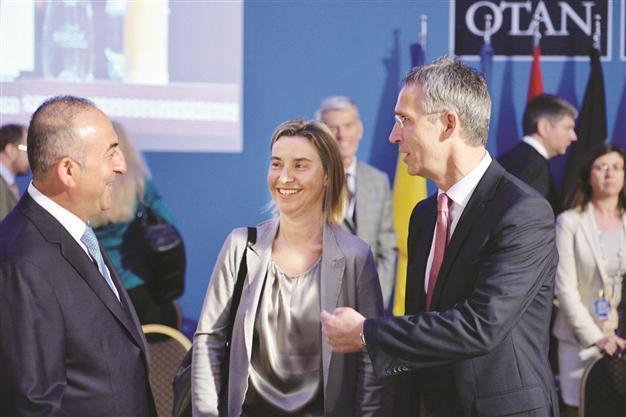Turkey offers to take lead in NATO’s rapid reaction forces
Sevil Erkuş - ANKARA

DHA Photo
Turkey has pledged to be a “framework nation” for NATO’s Very High Readiness Joint Task Force (VJTF) by 2021. The force was originally designed to serve as a deterrent to Russian aggression after President Vladimir Putin annexed Crimea and supported separatists in eastern Ukraine.Turkey hosted a foreign ministers’ meeting of NATO on May 13-14, where Ankara also proposed to host one of the alliance’s upcoming summits. The key outcome of NATO’s Wales summit a year ago was a Readiness Action Plan “to ensure the alliance is ready to respond swiftly and firmly to new security challenges” with a sense of urgency to counter the perceived threat of Russian aggression.
The VJTF will be fully operational by early 2017, but it will be declared operational at the next summit in Warsaw, due to take place in spring 2016.
The new quick-reaction forces, combining the armies of multiple member nations, will likely have 4,000 to 5,000 troops including sea, land and air forces. It will enable NATO to react within only a few days to any threat against Euro-Atlantic security, regardless of its source. Germany, Spain, Britain, France, Italy and Poland will take command of the VJTF on rotation.
The alliance will decide on the VJTF program at the upcoming NATO defense ministers’ meeting on June 23-24. NATO Secretary General Jens Stoltenberg responded positively to Turkey’s offer at the recent Antalya meeting. “I welcome the decision by Turkey today to be a lead nation for the Spearhead Force,” Stoltenberg said.
The new VJTF force will most likely be more expensive than its predecessors, as it will be put on a higher readiness level. Taking the lead of the Spearhead Force as a hosting country, Turkey will likely assume some part of the financial burden, with the support of NATO shared funds.
The Rapid Deployable Turkish Corps Headquarters, based at the 3rd Turkish Corps Headquarters near Istanbul, and the 28th Mechanized Infantry Brigade (also known as the “Peace Force Brigade”) in Ankara, are being considered as headquarters for the mission.
The force is likely to be tested in a number of exercises, leading to a higher number of NATO military activities in the region.
Meanwhile, nine Russian and Chinese navy vessels have gathered in the Mediterranean Sea for a joint military drill that will continue until May 21, the Russian Defense Ministry has stated.
The first joint military exercises by the two countries in the region come amid high tensions between Russia and the West over Ukraine, as China is increasingly assertive in pursuing territorial claims at sea.
Last week, around 20 vessels representing nine NATO member states conducted the Baltic Fortress 2015 exercises off the Lithuanian Baltic Sea coast.
At the Antalya meeting of NATO foreign ministers on May 15, Poland and the Baltic states of Lithuania, Latvia and Estonia said they were seeking permanent NATO deployments on their soil to counter increased Russian military activity.
All three former Soviet republics have Russian minorities and fear any Kremlin moves to inflame tensions after a pro-Russian insurrection in eastern Ukraine.
Turkey also recently donated 800,000 euros to the NATO trust fund for Defense Capacity Building of Iraq, Jordan and Moldova, in work to start a program for training a neighboring Iraqi army.
These moves by Ankara come amid claims from international media outlets that Turkey is stepping back from its role in the NATO alliance, suggesting that the country is pushing to carve out an independent foreign policy and purchase arms from countries outside of NATO.
















